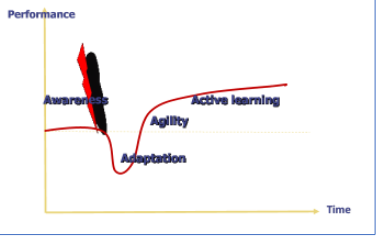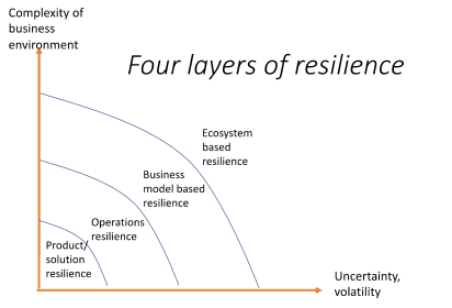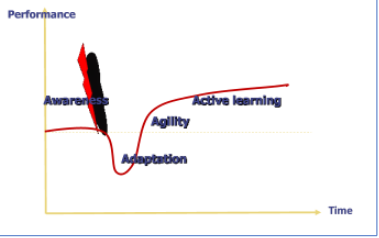[ISSUE&INSIGHT: X이벤트 ⑥] 회복력의 4개 층위
- 국가비전과 전략연구
- 위원회 및 연구단
- 발행기관경제ㆍ인문사회연구회
주요내용

레나 일몰라(Leena Illmola) 국제응용시스템분석연구소(IIASA) 연구위원
코로나19 사태는 지나가기만 기다리면 되는 일시적인 위기가 아니다. 이번 코로나19 사태로 인해 세계 경제의 다이내믹스는 영구적으로 바뀌었다. 불확실성으로 가득 찬 세상은 이제 기업들에게는 뉴노멀이 되었다. 이번 사태의 원인이 바이러스였다면 다음에 찾아올 위기는 우주의 자기파로 인한 인터넷 불통이나 정전사태가 될 수도 있다. 아니면 이보다는 파장이 작은 사건들, 예를 들면 오늘 아침 이 글을 쓸 때 일어난 수에즈운하 컨테이너선 좌초 사건 같은 일들이 위기를 초래할 수도 있다.
이런 위기에서 살아남는 문제에만 골몰하는 기업이나 조직은 실패할 수밖에 없다. 단순히 살아남는 데 그치지 않고 이제는 한 발 더 나아가 어떻게 하면 이런 글로벌 경제시스템의 불확실성을 이용해 이익을 얻을 수 있을 것인가를 고민해야 한다.
계속되는 격변의 시기에 성공하기 위해서는 i) 물리적 제품과 서비스를 적절히 조합하여 코로나19 사태, 극한 기후 상황, 주식 시장 침체, 무역 전쟁 등과 같은 변화에 신속히 적응하는 다차원적 해결책을 모색해야 한다. 이를 위해서는 ii) 비즈니스모델의 대대적인 혁신과 더불어 동시에 iii) 변화에 자동으로 적응하는 운영 프로세스를 갖추어야 한다. 하지만 한 기업이 가진 자원이 이러한 변화에 대한 적응 역량을 확보하기에 충분하지 않다면, iv) 기업 생태계 차원에서 회복력을 구축해야 한다. 공을 저글링 할 때 일시에 모든 공을 다 공중에 띄울 수 없듯이, 기업 경영진은 이상의 4가지 대안 중 어떤 대안을 추진할 것인지를 신중히 결정해야 한다.
회복력이란 무엇인가?
그렇다면 과연 회복력은 무엇을 의미하는가? 최근 여론에서는 ‘현재 의료시스템이 과연 코로나 환자를 제대로 케어할 수 있는 역량을 갖추고 있는가’라는 맥락에서 주로 회복력에 대한 논의를 이어가고 있다. 한편 비즈니스 매거진에서는 ‘회복력’이라는 단어를 디지털화와 거의 유사한 개념으로 사용하고 있다. 전통적인 공학적 개념에서는 ‘회복력’이란 충격 후에 일어나는 ‘반동’을 가리킨다. 하지만 기업이라는 맥락에서는 회복력을 이런 단순한 물리적 반동이라는 개념만으로 설명할 수 없다. 한 조직의 회복력은 i) 불확실성에 대한 지속적인 인식(awareness), ii) 충격이나 예상치 못한 일에 대한 신속한 적응(adaptation), iii) 충격적 상황으로부터 나오는 기회를 활용하는 민첩성(agility), iv) 충격과 충격 이후 상황을 향후의 개선을 이끌어내는 동인으로 활용하는 적극적 학습(active learning)이라는 ‘4A’, 즉 4개 파라미터로 이루어져야 한다. 최근에는 대체로 ‘예상치 못한 상황이 전개되고 있는 가운데 성공할 수 있는 능력’을 회복력으로 인식하고 있다.

I 카멜레온식 솔루션
코로나19 사태를 계기로 디지털화의 유용성이 입증되었다. 코로나19 격리 조치로 외출을 할 수 없는 사람들에게 디지털 기반 서비스와 유통 솔루션은 실질적으로 도움이 되었다. 하지만 이로 인해 회복력 있는 솔루션은 모두 디지털 방식이라고 자칫 오해를 할 수도 있다. 하지만 이는 사실이 아니다. 코로나19 사태에 이어 전세계적인 인터넷 불통이라는 또다른 위기가 발생한다면 그때는 디지털 서비스가 아예 작동하지 않을 수도 있다. 혹은 무역 전쟁으로 인해 공급망 연결이 끊어지는 상황도 발생할 수 있다. 소비자들이 자신들의 영향력을 이용해 사용자의 탄소 발자국을 증가시키는 해결책을 거부한다면 과연 어떤 일이 벌어지게 될까?
우리 중 다수는 이러한 새로운 솔루션을 최근에 경험했다. 코로나19 봉쇄조치로 인해 콘서트 등 문화 행사의 모습도 상당히 달라졌다. 콘서트홀에는 제한된 인원만 입장 가능하고 대신 전국 각지에서 친구들끼리 삼삼오오 모여 장소에 구애받지 않고 화상으로 중계되는 콘서트를 즐기고 있다.
회복력 있는 솔루션이라면 물리적 상품, 디지털 방식의 서비스, 환경 부담을 줄여주는 특징, 솔루션의 차별성을 담보해줄 수 있는 내재된 지식 등을 갖추어야 한다. 이러한 각각의 개별 특징과 이들 특징을 적절히 조합하기 위해서는 자체적인 혁신이 필요하다.
II 자동적 적응 및 자발적 혁신
일반적인 혁신 및 변화 관리 프로세스는 우리가 기존에 익히 알고 있던 익숙한 환경에 부담을 안겨준다. 개별적인 혁신 프로젝트와 변화 관리 프로그램들은 추진하는 데 상당한 시간이 걸리고, 최악의 경우에는 혁신과 변화 관리를 모두 내부의 전문 지식이나 자원에 의존하여 추진할 수밖에 없다.
거대 디지털 공룡 기업들이 운영하는 솔루션들, 예를 들면 구글의 Tensorflow 툴, Slack의 워크그룹 앱, 아마존의 시스템은 공통점이 있다. 이들 기업의 운영 프로세스는 고객들의 니즈 변화에 자동적으로 적응하도록 도와주는 요소를 포함하고 있다. 이처럼 운영 시스템 안에 내재된 역량을 가리켜 시스템혁신자원(Systems Innovation Resources, SIRs)이라고 부른다. 한 기업의 파트너, 고객, 공급업체의 행동의 변화는 기업 운영의 방향을 결정하는 이정표가 되는데, 시스템혁신자원을 갖춘 기업의 경우는 전통적인 기업 시스템에서 일반적으로 필요로 하는 경영진의 의사결정 과정이 필요 없고 혁신과 실행 사이의 시간적 갭 역시 발생하지 않는다. Tensorflow의 AI 기반 개발자 툴은 개별 앱에서 무엇인가 새로운 것을 배울 수 있고, Slack 유저들은 자신들이 직접 사용할 앱을 개발하는데 이 앱을 다른 사람들도 활용할 수 있다. 한편 아마존 서비스는 소비자들의 행동에 맞춘 맞춤형 서비스를 지속적으로 제공한다. 이러한 자동적인 변화는 적응을 가속화시켜, 그 결과 ‘제품 개발 프로젝트’를 따로 추진할 필요가 없다.
지속적인 적응은 여러 단계에 걸쳐 진행된다. 고객과의 상호작용 과정에서 수집한 데이터는 적절한 진단 과정을 거쳐 급격한 혁신을 위한 발판 역할을 하게 된다. 또한 디지털화는 고객을 혁신주체로 활용할 수 있도록 해 준다. Slack 유저들은 자신들만의 앱이나 워크플로(workflow)를 개발하고 Slack 채널의 다른 유저들은 이를 활용한다. 이처럼 Slack 플랫폼은 고객이 직접 개발한 앱이나 워크플로를 구현하는 공동의 장이 된다.
아마존은 SIR을 자사의 모든 운영 시스템에 통합하였다. 한편 아마존은 전체 비즈니스 프로세스를 혁신 프로세스라고 정의하고 있어, 미 연방세무국과 의견 충돌을 빚고 있다.
III 독창적인(Out-of-box) 비즈니스 모델
예상을 벗어나는 시장에서는 융합형 제품이 살아남을 가능성이 높고 자동적으로 진행되는 개발을 통해 민첩성이 증대될 수 있다. 하지만 비연속성이 크고 사소한 변화에 시장이 좌지우지되는 상황에서는 융합형 제품이나 민첩성과 같은 회복력의 원천 요소들만으로 충분하지 않을 때가 있다.
기업의 수익 창출 논리라고 할 수 있는 기업의 비즈니스 모델도 이제는 기존의 전통적인 비즈니스 모델에서 벗어나야 한다. 모두가 알다시피 호텔들도 이제 더 이상 객실을 소유할 필요가 없고, 택시 회사들도 차량을 소유할 필요가 없으며, 배달업체들도 더 이상 배달인력을 고용할 필요가 없다. 사용자들이 인터넷 기반 서비스를 무료로 이용하고, 파이낸싱을 통해 생산이 이루어지고, 사용자 데이터 판매를 통해 수익을 올리는 것이 이제는 꽤나 논리적으로 말이 되는 일이다. 오랜 동안 투자자들은 수익을 창출할 의향이 없는 기업에도 기꺼이 투자를 해왔는데, 기업의 영업 이익은 증가하지 않아도 기업의 시가총액 상승으로 투자 수익은 발생한다. 이제 소비자들은 전기드릴이나 스키 등과 같이 자신들이 가진 자원을 아무 보상 없이 기꺼이 이웃들과 공유하고자 한다. 이러한 새로운 비즈니스 모델은 가격 책정, 기업 통제, 수익 창출 등과 같은 기존의 전통적인 규칙들을 파괴한다.
이러한 새로운 공유형 비즈니스 모델은 자본의 구속을 줄여주고 유휴 자원을 보다 효율적으로 활용할 수 있도록 해준다. 또한 이러한 공유형 비즈니스 모델은 여러 다양한 리스크에 대해 보다 유연하게 대처할 수 있게 해 준다. 동시에 이들 비즈니스 모델이 필요로 하는 인프라 요건 역시 그다지 높지 않아 자원의 신속한 배치를 통해 새로운 시장 기회에 보다 기민하게 대응할 수 있다.
IV 한 기업의 회복력만으로는 충분하지 않은 경우
계속되는 정전 사태나 매주 그 양상이 바뀌는 무역 전쟁에 대비하는 일은 단일 기업이 보유한 자원만으로는 해결할 수 없는 과제로, 기업 생태계 차원에서의 적응과 기민한 기회 활용이 요구된다. 생태계는 ‘예상치 못한 상황에 대응하는 데 도움이 되는 다양성을 포용할 정도의 방대한 경제 시스템 개체’라고 정의할 수 있다. 간단한 예를 들자면, 무역 전쟁이나 수에즈운하 봉쇄로 인해 부품 수급이 원활하지 않게 되면, 생태계 구성원들은 여분의 부품 재고를 서로 공유할 수 있다. 생태계 기업의 가장 큰 장점은 이 부품 수급 사례에서 볼 수 있듯이 단일 기업 차원에서 최적화가 일어나는 것이 아니라 전체 생태계 차원에서의 최적화가 진행된다는 것이다. 이와 동시에 생태계 전체에 걸쳐 물류 솔루션을 개선하는 과정에서 완전히 새로운 차원의 효율을 달성할 수 있다.
한계란 없다. 다만 가격으로 인한 제한은 존재한다.
재정 부족이 창의성을 제약하는 경우가 아니라면 이론적으로는 다양한 상황에 대한 상품이나 솔루션 개발, 운영 통제를 위한 고객 상호작용 정보 활용, 새로운 실험적 비즈니스 모델, 생태계 차원의 협력 등 모든 것이 가능하다. 하지만 현실에서는 투자자들은 투자 대상을 선택하는 데 신중하고, 고객들은 무엇보다 비용에 민감하다. 혁신은 이전보다 더 회복력이 높고, 생태적으로 더 건전하고, 비용면에서 더 합리적인 운영모델과 솔루션을 개발하는 것을 가능하게 해 준다.

<표> 기업환경의 특성과 더불어 발생 가능성이 낮은 사건들이 가져올 잠재적 영향을 동시에 고려해 회복력의 어느 층위에 투자를 할 것인지를 결정
혁신주체, 스타트업, 비즈니스 개발 주체, 최고경영진은 회복력 있는 투자의 가치에 대해 투자자들을 설득해야 한다. 100년에 한 번 정도 있을법한 리스크를 감당할 수 있도록 기업의 회복력 요건을 설계하는 것은 결코 현명한 선택은 아니다. 하지만 기업의 상품, 기업 운영 혹은 기업 생태계가 이런 종류의 리스크에 대해 회복력을 가진다는 것은 결코 나쁜 일은 아니다. 혁신과 동시에 회복력 확보 전략을 수립하는 가장 좋은 방법은 체계적인 계획 수립을 통해 다양한 충격에 대해 회복력을 지니는 여러 전략을 믹스해 최적의 전략 포트폴리오를 구축하는 것이다.
회복력 평가를 실시하는 가장 쉬운 방법으로 먼저 5가지 각기 다른 충격이 무엇인지를 정의하고, 이들 충격이 가져올 변화를 기술하고, 귀사가 가진 솔루션(상품/서비스)이나 기업 운영, 비즈니스 모델, 기업 생태계가 여러 다양한 상황에서 여전히 유효한지를 테스트해볼 수 있다.
FOUR LAYERS FOR RESILIENCE
Leena Illmola
The Covid Pandemics is not a transient crisis, that we can wait to pass by. The dynamics of the global economy is changed forever. A world filled with uncertainties is the new normal where a business operates. Now the cause of the upheavals is a virus, next it may be internet failure or electricity outages caused by a magnetic pulse from space. Or something smaller – as this morning when I write this article – the container ship that blocks Suez-Canal.
Those companies or organizations that try to survive from the various crisis, will fail. The ambition level should be higher; how to benefit from the unpredictability of the global economic system.
Succeeding in a world of ongoing turbulence requires a multidimensional solution, a combination of physical products and services that should adapt quickly to pandemics, extreme weather events, stock market drags, and trade wars. Success requires a radical innovation of business models and, at the same time, operations processes that automatically adapt to change. If the resources of a single firm are not sufficient to build the required adaptive capacity, resilience can be built into ecosystems. The management of the company must decide which of these four balls is always kept in the air, a juggler whose skills would be enough to keep everyone in the air is hard to find.
Resilience, what is it?
What do we mean by resilience? The recent public rhetoric is speaking about resilience in the context of health care systems’ capability to take care of Covid patients. The business magazines use the term ‘resilience’ close to a synonym for digitalization. The traditional engineering concept of resilience is referring to ‘bouncing back’ after a shock. That will not be enough in the business context. We claim that the resilience of any organization should consist of four parameters, four A’s: continuous awareness of uncertainties, fast adaptation to the shock or surprise, agility to utilize the opportunities that are emerging from the shock of the situation and active learning, that uses a shock and its aftermath as a trigger for improvement. Modern resilience is referring to the capability to succeed in the middle of surprises.

I Chameleon solution
During a pandemic, digitalization has proven useful. The digital-based services and distribution solutions have rescued many who have been trapped in a Covid quarantine. At times, it seems that the resilient solution is digital. This is not true. If the next shock arises from the constant disruption of the global internet, digital services will not work. Or trade wars will cut off supply chain connections. What if consumers finally will use their power and reject solutions that increase the user’s carbon footprint?
Many of us have experienced novel solutions lately. Due to the Covid, lock-down concerts and cultural events have transformed. Limited audience in the concert hall, virtual broadcasting to a small group of friends that listen to the concert at the local clubhouses around the country.
A resilient solution consists of a physical product, a digital service, features that reduce the load on the environment, and the knowledge integrated with the solution that makes it unique. Each feature and especially the right composition of them require its own innovations.
II Automatic adaptation & self-organizing innovation
Traditional innovation and change management processes form a burden in the environment we are speaking about. Separate innovation projects, and change management programs take too much time. And in the worst of cases both of these operations rely on internal expertise and resources.
Digital giants operations, Google’s Tensorflow tools, Slack’s workgroup apps, and Amazon’s systems have something in common. There is something in the operational processes of these organizations that helps them automatically adapt to changing needs of their customers. This in-built capability of their operations is called Systems Innovation Resources (SIRs). Changes in the behavior of a company's partners, customers, or suppliers guide the company's operations without management’s decisions and lag necessary between innovation and implementation in a traditional business system. Tensorflow’s AI-based developer tools learn something new from each app, Slack users develop their own apps that are offered for use by others, and Amazon’s service still adapts to consumer behavior during the same session. Automated changes speed up adaptation and make ‘product development projects’ largely unnecessary.
Continuous adaptation takes place in small steps, while data collected in customer interactions, when properly diagnosed, produces a stepping board for radical innovation. Digitalization is also enabling the use of customers as innovators. Slack users can develop their own applications or workflows for the use of other users of the Slack channels. The role of a Slack platform is to enable the customer-produced development.
Amazon has integrated SIRs into all its operations. Amazon has been in conflict with the federal tax authorities of the US because Amazon defines the entire business process as an innovation process.
III Out-of-box business model
In a market of surprises, a hybrid product can survive, and agility can be increased by automated development, but these sources of resilience are not enough when discontinuities are large and markets are shaped with elementary disruptions.
The business model - the logic by which a company makes a profit - must move away from the traditional. We already understand that hotels do not have to own rooms, taxi companies do have to own cars, or a courier service does not have to employ couriers. We find it very logical that the users get their internet-based service for free and production is financed and profits generated by selling user data. For a long time now, investors have been willing to invest in companies that do not intend to make a profit from their operations, but the actual return for investors arises from the increase in the market CAP. Consumers are willing to share their own resources with their community, such as electric drills or skis, without compensation. The novel business models break in some way the traditional rules of pricing, business control, and request for profit.
All these features reduce tied capital and take lazy resources into active usage more efficiently. Novel business models are designed to be more resilient to various risks and simultaneously the low amount of infrastructure requirements allows for fast deployment of resources to react rapidly to new market opportunities.
IV When resilience of one company is not sufficient.
When preparing for ongoing power outages or a weekly deforming trade war exceeds the resources of a single company, then adaptation and agile exploitation of opportunities must take place at an ecosystem level. The ecosystem as an economic entity is large enough to contain diversity within it to help respond to unexpected situations. A simple example: if a trade war or blockage of the Suez Canal prevents shipments of components, ecosystem members can share the excess storage of components. The biggest advantage of an ecosystem business is that optimization no longer takes place at the operational level of a single company, but the ecosystem can optimize over the entire ecosystem, as in our component inventory example. But at the same time, a whole new efficiency can be found in improving, for example, logistical solutions throughout the ecosystem.
No limits – but price constraints
All this is possible. Development of products and solutions adaptable for various situations, the use of customer interaction in operational control, new experimental business models, and ecosystem-level cooperation are possible if money does not limit creativity. In reality, investors are carefully considering what they are financing and consumers are more cost-conscious than ever. The innovation is that at the same time it is possible to develop operating models and produce solutions that are both resilient, ecological, and more affordable than before.

Figure 3. The nature of the business environment and the potential impact of low probability events define which layers of resilience should be invested in.
Innovators, start-ups, business developers, and top management have to convince investors about the usefulness of resilience investments. It is not wise to design your business just to meet the resilience requirements for once-in-every-hundred-year risk, but if your product, business operations, or ecosystem is resilient also for these kinds of risks, that is not bad. The best way both to innovate and plan for resilient strategies is to use systematic planning methods that lead to the best affordable portfolio of strategies that are simultaneously resilient to various shocks.
The easiest way to conduct a resilience assessment is to define five very different shocks, describe the changes those shocks create in your markets and then test if your solution (product/service), your business operations, your business model and your ecosystem is viable across those contexts.

![ISSUE&INSIGHT : X-EVENT [X이벤트를 시작하며] 박병원 과학기술정책연구원 연구위원 - 칼럼 바로가기](http://www.nrc.re.kr/ease_src/crosseditor/binary/images/000041/20210423164608601_R7PRZYLG.png)
![ISSUE&INSIGHT : X-EVENT [X이벤트와 인간 사회의 붕괴] John Casti(The Global X-Network - 칼럼 바로가기](http://www.nrc.re.kr/ease_src/crosseditor/binary/images/000041/20210423164619829_I37L54OG.png)
![ISSUE&INSIGHT : X-EVENT [현실이 된 X이벤트의 교훈] 윤정현 과학기술정책연구원 선임연구원 - 칼럼 바로가기](http://www.nrc.re.kr/ease_src/crosseditor/binary/images/000041/20210430110136641_3CGSYFBT.png)
![ISSUE&INSIGHT : X-EVENT [탈진실운동(post-fact movements)의 심리학] 토마스 브루터만(Thomas Brudermann) 오스트리아 그라츠대학 교수 - 칼럼 바로가기](http://www.nrc.re.kr/ease_src/crosseditor/binary/images/000042/20210507134512692_FJTW587O.png)
![ISSUE&INSIGHT : X-EVENT [초불확성 시대의 극단적 사건과 미래전략] 서용석 KAIST 문술미래전략대학원 교수 - 칼럼 바로가기](http://www.nrc.re.kr/ease_src/crosseditor/binary/images/000043/20210520164016865_WAL2E1OJ.png)